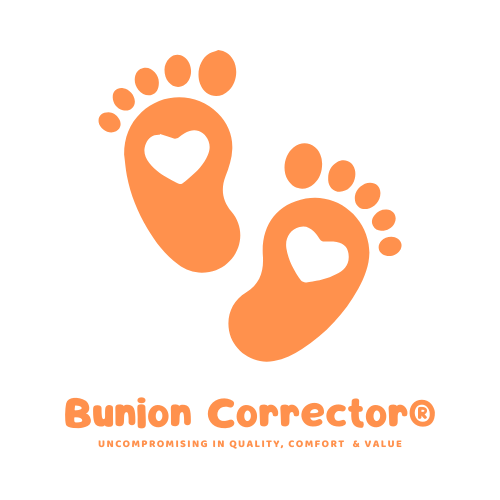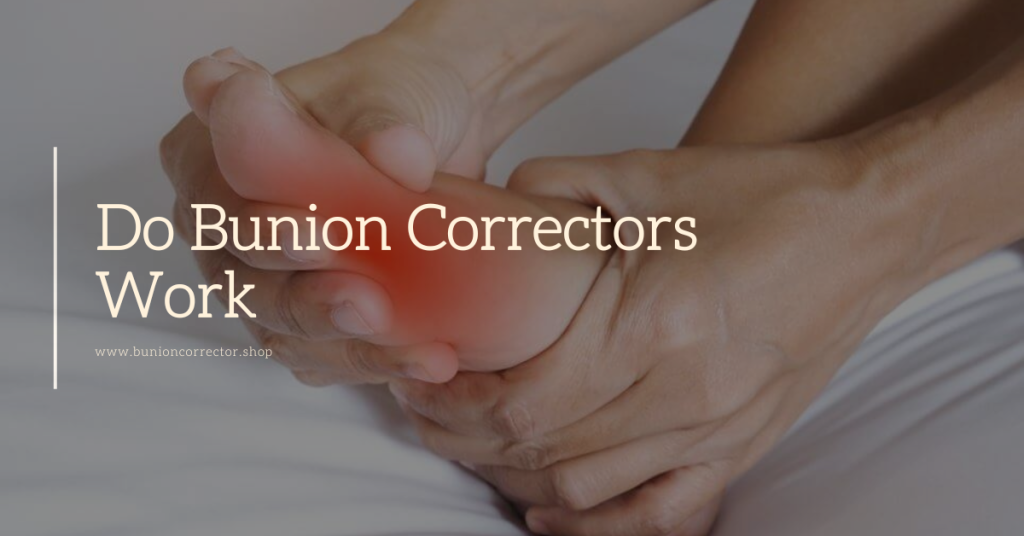Before we dive into the topic of bunion correctors, let’s first understand what a bunion is? Do Bunion Correctors Work. A bunion, medically known as hallux valgus, is a bony bump that forms on the joint at the base of your big toe. Over time, the big toe may lean toward the other toes, causing the joint to protrude. This can lead to discomfort, pain, and difficulty walking, especially when wearing tight or narrow shoes.

What Is a Bunion?
Common Causes of Bunions
Bunions can develop due to various factors, such as:
- Genetics: If bunions run in your family, you are more likely to create them.
- Footwear: High heels or shoes that are too tight can worsen or cause bunions.
- Foot Shape: People with flat feet or low arches are more prone to bunions.
- Arthritis: Conditions like rheumatoid arthritis may increase your risk of developing bunions.
What Are Bunion Correctors?
Do Bunion Correctors Work? Now that we know what bunions are let’s talk about bunion correctors. A bunion corrector is designed to realign the big toe, relieve pressure, and reduce pain caused by bunions. These devices come in many forms, such as splints, pads, and toe spacers. Most people use bunion correctors to avoid or delay surgery, while others may use them for post-surgical recovery.
How Do Bunion Correctors Work?
Bunion correctors primarily work by providing support and alignment to the big toe. Here’s how they help:
- Realignment of the Big Toe
Bunion correctors aim to realign the big toe to its natural position gently. By doing this, they relieve the pressure on the bunion and the surrounding joints. Some correctors use a splint that holds the big toe in place while you rest or sleep, while others provide ongoing support during the day.
- Pain Relief
Bunions can be pretty painful, especially if they are left untreated. Bunion correctors cushion the bunion area, reducing friction between the bunion and your footwear. This cushioning helps alleviate pain, making it easier to go about daily activities without constant discomfort.
- Prevent Further Progression
Do Bunion Correctors Work? One of the main advantages of using a bunion corrector is its ability to prevent the bunion from worsening. While it may not completely reverse the deformity, regularly utilizing a corrector can slow the progression and reduce symptoms.
- Support for Posture and Balance
By realigning your toes and correcting your foot position, bunion correctors can also improve your overall posture and balance. This is particularly beneficial for people who experience foot fatigue or joint pain in other areas, such as the knees and hips, due to poor foot alignment.
Do Bunion Correctors Work?
Temporary Relief vs. Long-Term Solution
Regarding bunion correctors, the results vary from person to person. Bunion correctors provide significant relief for some individuals, reducing pain and discomfort. However, it is essential to note that they are not a cure for bunions. Bunion correctors are most effective in providing temporary relief rather than a permanent solution.
Short-Term Benefits
- Pain Reduction: Many people experience immediate relief from pain when using bunion correctors, especially at night.
- Increased Comfort: Correctors can help ease the discomfort caused by tight or narrow shoes by providing a cushion around the bunion.
- Improved Mobility: Some individuals report better mobility and less toe stiffness after consistent use.
Long-Term Effectiveness
While bunion correctors can slow down the progression of bunions, they cannot reverse the condition. Severe bunions often require surgery to correct the deformity. That being said, regularly wearing a bunion corrector can help maintain foot health and reduce symptoms, potentially postponing surgical intervention.

Types of Bunion Correctors
There are several types of bunion correctors available on the market. Let’s look at the most common types and their benefits:
1. Bunion Splints
Bunion splints are typically worn at night. They hold the big toe in a straighter position while you sleep, helping to reduce pressure on the joint and keep the toe properly aligned.
- Pros: It can be highly effective in realigning the big toe overnight.
- Cons: Not suitable for daytime use or when walking.
2. Toe Separators and Spacers
Toe separators are small devices between the toes to keep them adequately spaced apart. These are often worn daily to provide relief while walking or standing.
- Pros: Comfortable for daytime use, helps relieve mild to moderate bunion pain.
- Cons: It may not provide enough realignment for severe bunions.
3. Bunion Pads and Cushions
Bunion pads provide a cushion between the bunion and your shoe, reducing friction and pressure. While they don’t correct the toe’s position, they offer much-needed comfort, especially for people who wear tight or stiff shoes.
- Pros: Affordable, easy to use, and ideal for immediate pain relief.
- Cons: Does not realign the toe or address the underlying cause of bunions.
4. Gel Sleeves
Gel sleeves combine the cushioning effect of a bunion pad with a soft sleeve that fits over the foot. These are excellent for all-day use as they provide continuous support and relief from bunion pain.
- Pros: Provides both cushioning and alignment support and can be worn with shoes.
- Cons: It may be less effective for severe bunions.
How to Choose the Right Bunion Corrector
Choosing the suitable bunion corrector depends on your specific needs and the severity of your condition. Here are some tips to help you decide:
- For Mild Bunions: A simple toe spacer or cushion pad can relieve minor bunions adequately.
- For Moderate Bunions: A gel sleeve or daytime corrector may offer more support while still being comfortable to wear during daily activities.
- For Severe Bunions: A nighttime splint is your best bet for realigning the toe, although you may still need surgery if the bunion is particularly large or painful.
Additional Tips for Managing Bunions
In addition to using a bunion corrector, here are some lifestyle tips to help manage your bunions:
- Wear Comfortable Shoes: Opt for shoes with a wide toe box to avoid putting pressure on your bunion.
- Stretch Your Feet: Regular foot exercises and stretches can help maintain flexibility and reduce pain.
- Use Ice Packs: Applying an ice pack to your bunion can reduce inflammation and relieve swelling.
- Visit a Podiatrist: If you’re unsure about your condition or if your symptoms worsen, it’s always a good idea to consult a podiatrist for professional advice.
Conclusion: Are Bunion Correctors Worth It?
So, do bunion correctors work? The answer is yes – but with some limitations. While they won’t permanently fix your bunion, they can relieve pain, prevent the condition from worsening, and improve your comfort. Whether you’re looking for short-term relief or trying to delay surgery, bunion correctors can play a helpful role in managing bunions.